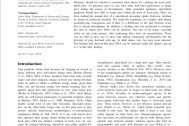Obsah
Predators should be selected to maximize their fitness by catching the most profitable prey. As predators grow in size, they often shift their preferences to larger prey during the course of development. Alike generalist predators, specialized predators should also shift to larger prey within the pool of focal prey. Here, we have studied the natural diet of a specialized ant‐eating spider Zodarion rubidum by means of molecular methods. We tested the hypothesis of a trophic shift during postembryonic ontogenesis and if there is a difference in the diet between sexes due to sexual dimorphism. In addition, a feeding trial was performed to estimate the time at which prey DNA can be detected. The diet of all stages consisted solely of ants (nine genera), thus confirming their strict ant specialization. There was no shift in prey size or prey type during ontogenetic development, but the diversity of prey declined with age. In adult males, very few prey were detected. The feeding trial showed that prey DNA can be detected inside the spider’s gut up to 2 weeks after feeding.



